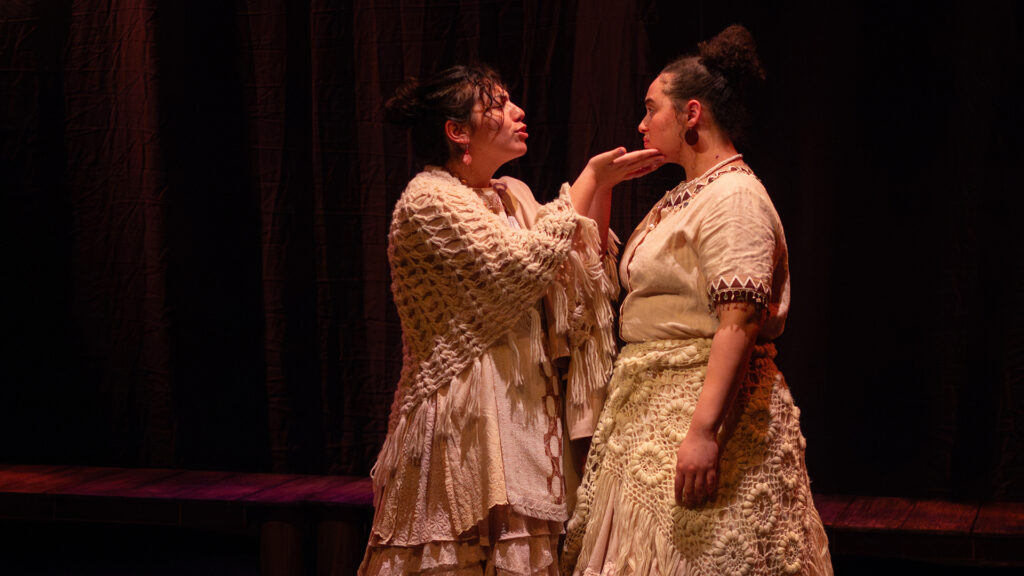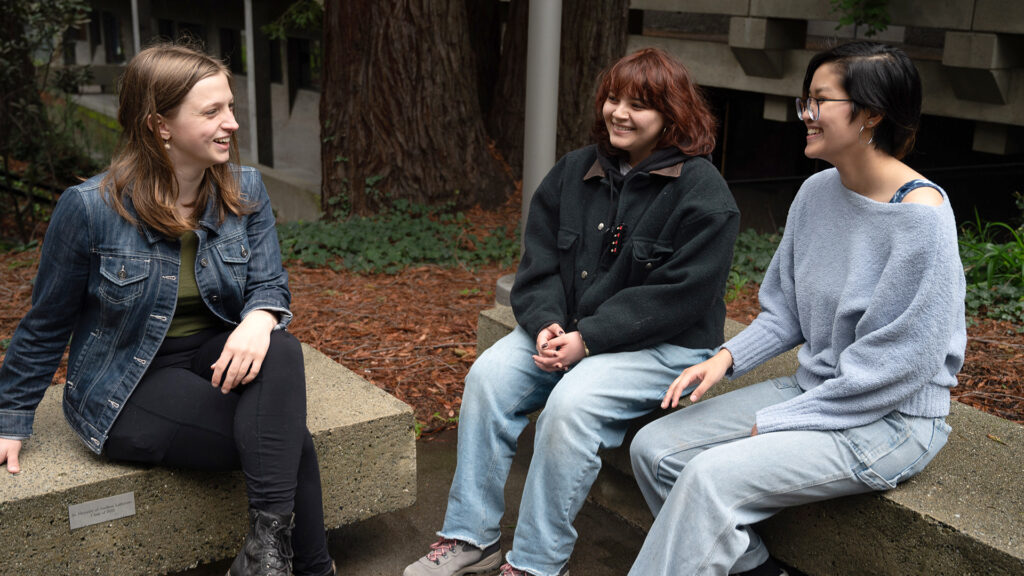Student designers build a magical realm for Brazilian folktale ‘The River Bride’
March 12, 2024
This Thursday through Sunday, UC Berkeley’s Department of Theater, Dance and Performance Studies will present Marisela Treviño Orta’s The River Bride.
In the play, set in a small Brazilian fishing village, a mysterious man is fished from the Amazon River three days before a wedding. Brazilian folklore and lyrical storytelling blend to share a tale of true love, regret, transformation and two sisters who struggle to stay true to each other, while staying true to themselves.

Ben Dillon/UC Berkeley
At Berkeley, The River Bride has an all-Latinx and Black student cast and an all-student design team (with the exception of the sound designer, a lecturer in the department). Mirin Scassellati is the scenic designer, Lee Garber-Patel is the costume designer and Amy Abad is the lighting designer. Before the show was cast in January, the designers, all of whom will graduate from Berkeley this May, spent months imagining the world the play is set in.
“We didn’t start with what we wanted it to look like, but what does it feel like to be in this world?” said Scassellati. “How do we want the audience to feel? How do we capture the feeling of being in a river? Of being in a jungle? In the end, it comes down to emotions.”

Brandon Sánchez Mejia/UC Berkeley
To make this happen, she said, the designers had to work closely as a team. One thing they talked a lot about is the idea of magical realism, an artistic tradition that comes out of Latin America that paints a realistic view of the world while also adding magical elements, often blurring the lines between fantasy and reality.
“It’s really thinking about how people perceive the world — if someone believes something to be true, then it’s true. And so, if the actors on stage believe that they are in the river, and they walk like they’re in a river, and it sounds like they’re in a river, then it’s a river,” said Scassellati. Huge parts of the sets are interactive — there are big docks that move around and shift, as the tides go in and out in the story.

Ben Dillon/UC Berkeley
After reading the script, Garber-Patel was inspired by the forest — not only the blues and greens, but the brightly colored animals within the forest, like macaws and parrots. But the director had a different vision — she wanted the costumes to be shades of white to represent timelessness and spacelessness.
“So I started drawing inspiration from Afrofuturism and kind of played with what things could look like in an Indigenous fairy tale fantasy,” said Garber-Patel. Because everyone is dressed mostly in white, Garber-Patel knew they needed to find different ways to communicate relationships, occupations and traits of the people and stories in the play through the costumes.
“The show revolves around the stranger who comes directly out of the river — he’s an outsider, so he’s in the brightest shades of white,” they said. “His notions are all kind of unnatural, so they’re in sequins and plastic, iridescent stuff, instead of the natural colors of stone, wood and bone that I was looking at for all the other characters.
“A lot of the color comes in the little details, like trim and buttons and a lot of layering. I tried to build complexity in texture and silhouette and shape versus in color and pattern.”

Ben Dillon/UC Berkeley
There’s a lot of weather that happens in the play, said Abad, and a lot of time changes. To create the feeling of storms with rain and wind and lightning — all happening in a kind of magical realm in a fluid timeline — Abad worked with the director to introduce shadow play so that lights would go through set pieces and create different textures.
“While the setup is something that really physically constructs the world, and the costumes really develop the characters, I imagined the lighting as something that really fleshes out and connects the two,” he said. “Lighting helps establish the mood and draws attention to the details of the set and costumes.”
Lighting is also used as foreshadowing — a shimmery water effect shows up in important moments very subtly, connecting the mysterious outsider to other characters who share traits with him. Abad was told to be bold with her lighting colors — there are a lot of ambers, blues and greens, and in specific magical moments, there are also deep purples and pink lightning, “colors we wouldn’t necessarily see in nature, but are familiar enough and yet fantastical enough where it makes you know that something exciting or important is happening,” she said.

Mirin Scassellati
For the designers, who had to produce virtual theater productions for an entire year because of COVID restrictions, being involved in The River Bride drove home the importance of working in person.“There really is something about being physically in person, and about being together and sharing stories together,” said Scassellati.
“This is a fairy tale, but it comes out of an oral storytelling tradition. This is not a story that got written down. People told it to their children, and then they told it to their children, and so on. So that spirit of storytelling, of community, of being together and having that communal emotional experience, is really central to the play.”

Brandon Sánchez Mejia/UC Berkeley
And, said Abad, in theater at Berkeley, there’s room for mistakes that doesn’t exist in a lot of other academic disciplines on campus, and in the outside theater world.
“We can go to our faculty supervisors and be like, ‘I don’t know if this is going to work,’ and you’re able to have all these ideas and push your vision, but at the same time, they’re not going to let you push something that isn’t going to work. And I feel like that helps us feel passionate about this production.”
The River Bride opens on Thursday, March 14, and will run through Sunday, March 17. For more information about the production and to buy tickets, visit the Department of Theater, Dance and Performance Studies’ website.